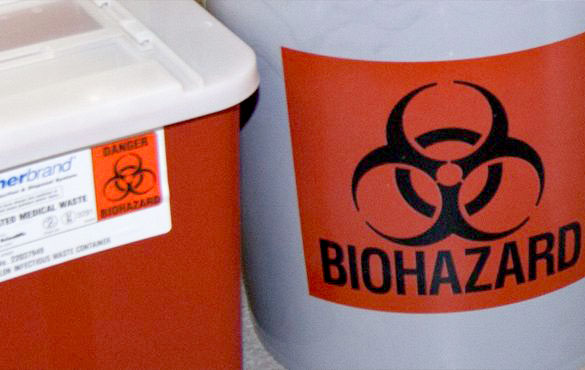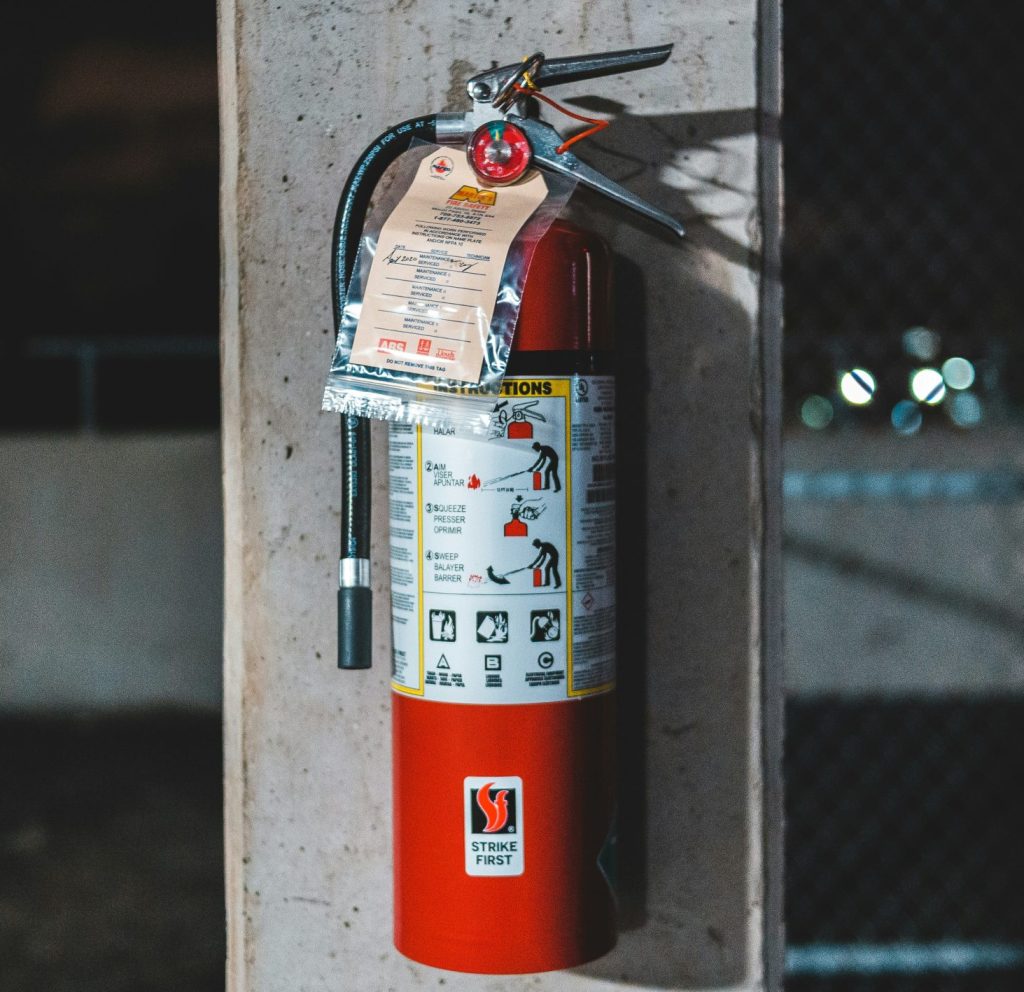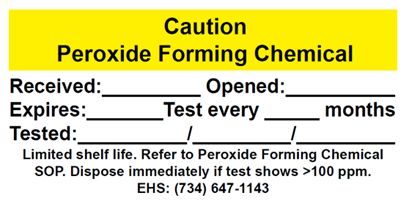Chemical
Chemical safety begins with lab directors (faculty/lab managers/supervisors) identifying and reducing the risks involved when working with chemicals. As a lab director, you are required to adopt and implement the University of Michigan (U-M) Standard Chemical Hygiene Plan (CHP), and where necessary, write Standard Operating Procedures (SOPs) for safety specific to the hazardous materials and methods used in your lab.
Chemical Hygiene Plan
Proper use of the CHP helps to ensure that research faculty, staff, and students who handle hazardous chemicals have the proper training and safety protections required under the law. The CHP provides the basic rules and guidelines generic to U-M research operations and every member of the laboratory is expected to read and understand it.
Standard Operating Procedures
Templates
NOTE: This list will be updated as new SOPs are developed either by Environment, Health & Safety (EHS) or members of the U-M research community – please share your SOPs with others by sending a copy to EHSLabSafety@umich.edu.
- Acrylamide – 11/10/2023
- Acutely Toxic Chemicals – 7/5/2022
- Animal Anesthetics – 6/17/2022
- Aqua Regia – 5/11/2022
- Asphyxiants – 3/21/2022
- Autoclaves
- Benzene – 1/22/2024
- Beryllium Vacuum Windows
- Biological Toxins – 1/24/2024
- Biosafety Cabinets
- Bleach – 12/19/2023
- B-Mercaptoethanol
- Bromo-Deoxyuridine (BrdU) – 2/13/2024
- Bunsen Burners
- Carcinogens
- Centrifuge Safety
- Chemicals and Drugs Administered to Animals in Standard Housing
- Chloroform
- Combustible Metals
- Compressed Gasses
- Compressed Oxygen Greater than 25%
- Controlled Substances
- Corrosive Chemicals
- Cryogenic Materials
- Cytotoxins
- Diethyl Ether
- Electrophoresis
- Environmental Rooms
- Ethidium Bromide – 12/20/2023
- Explosives
- Flammables and Combustibles – 2/26/2025
- Fluorouracil – 2/13/2024
- Formalin and Paraformaldehyde
- Fume Hoods
- Hydrofluoric Acid and Related Fluoride-Containing Mixtures– 12/20/2023
- Irritants
- Laboratory Emergencies SOP
- Laser Safety
- Lecture Bottles – 12/13/2023
- Machinery
- Magnet Safety
- MBE Chamber
- Methylene Chloride – Refer to the U-M Workplace Chemical Protection Program
- Nanomaterials
- Needle Recapping & Handling
- Nitric Acid
- Osmium Tetroxide
- Oxidizing Chemicals – 9/14/2023
- Perchloric Acid
- Peroxide Forming Chemicals
- Phenol – 10/30/2023
- Picric Acid – 12/20/2023
- Piranha Solution – 11/20/2023
- Pressure and Vacuum
- Pyrophoric Materials
- Rapamycin
- Reproductive Toxins
- Safe Use of Syringes, Cannulas, and Needles with Hazardous Chemicals – 8/31/2023
- Self-Reactive and Self-Heating Chemicals – 11/20/2023
- Sensitizers – 1/4/2024
- Sodium Azide – 12/20/2023
- Sodium Hydroxide and Ethanol Bath – 12/20/2023
- Streptozocin – 2/13/2024
- Sulfuric Acid – 10/11/2023
- Tamoxifen – 2/13/24
- Tetrahydrofuran
- Toxic Gases – 11/29/2023
- Tricaine Methanesulfonate (MS-222)
- Ultraviolet Radiation
- Uranyl E-M Staining Compound – 12/20/2023
- Vacuum Pumps
- Water Sensitive Chemicals
Chemical Labeling
Labels are a highly effective and efficient method to communicate hazard information and prevent accidents and injuries. Clear and consistent labeling that follows the MIOSHA Hazard Communication Standard (HCS) is required in all University of Michigan laboratories, shops, studios, and other locations where employees use, store, or transport chemicals.
The HCS as it applies to laboratories requires that labels on incoming containers of hazardous chemicals must not be removed or defaced until the container is empty and rinsed. No chemical shall be accepted without an adequate identifying label. Original containers should be labeled with the date received and the date opened. This is particularly important for peroxide-forming compounds and other chemicals that become unstable over time, and it is good laboratory practice for ALL chemicals.
Many University workplaces, including laboratories, shops, and other facilities, purchase hazardous chemicals or products in large quantities, concentrates, or for mixing with other chemicals. To use the chemical/product it may need to be transferred to a smaller or different “secondary” container (e.g., vials, flasks or bottles) for dilution, mixing, or general use. The HCS requires secondary chemical container labels contain at least the following information:
- Full chemical name (no abbreviations)
- Concentration (e.g., percent, molarity, etc.)
- Hazards, if known or suspected (e.g., “flammable”, “corrosive”, “irritant”)
If you transfer a hazardous chemical into a secondary container, the secondary container must be correctly labeled to ensure workers are readily aware of the contents and understand the hazards. Labels can be handwritten or printed.
Secondary container labels are not required if both of the following apply:
- The reagent, stock solution and chemicals mixed for use are under the direct control of the person who transferred or prepared it, and
- The container will be emptied during that person’s work shift.
EHS has a limited selection of secondary chemical container labels that labs can request. Click the link above for more details and to place an order. Availability is not guaranteed. Labels will be delivered via campus mail. Labels are available in the two sizes shown below, with or without a protective cover sheet.

Downloadable label templates
EHS has developed templates for labs to make their own customized labels for use on secondary chemical containers. All templates are sized for printing on Avery 5263 or other compatible 2” x 4” label sheets.
In addition, the GoldFFX Safety Data Sheet program has the capability of creating and printing various size labels for use in the lab.
Peroxide-forming Chemical Labels
Containers with peroxide-forming chemicals listed in the Peroxide Forming Chemicals SOP, must be dated upon receipt and again when the container is opened so that the user can dispose of the material according to the recommendations on the SDS. Peroxide formers must be tested regularly as outlined in the SOP. For more information about labeling, storage, and handling of peroxide-forming chemicals, refer to the Peroxide Forming Chemicals SOP.
EHS has developed templates for labs to make their own labels for use with peroxide-forming chemicals. There are two size options available depending on the size of the container.
EHS has developed templates for labs to make their own labels for use with peroxide-forming chemicals. There are two size options available depending on the size of the container.
Chemical Waste Labels
All chemical waste containers must be labeled with the appropriate hazardous waste label. Containers need to be labeled as soon as waste begins to be accumulated in them. Hazardous waste labels are available by request on the EHS website.










